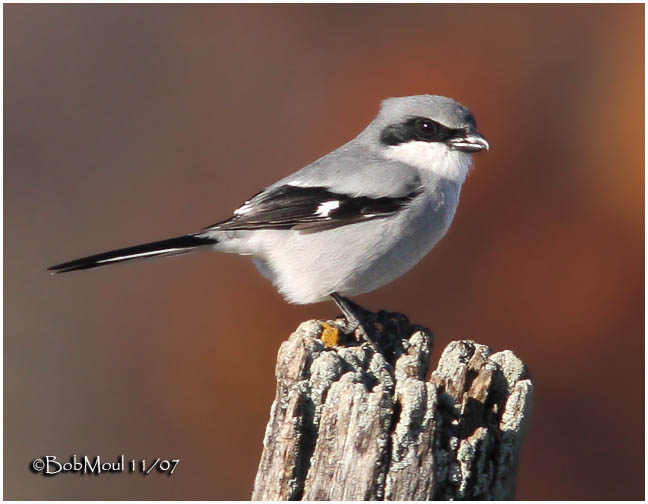
Loggerhead Shrike
Lanius ludovicianus
Passeriforme Order – Laniidae Family
BIOMETRICS :
Length : 20-23 cm
Wingspan : 28-32 cm
Weight : 35-50 g
LONGEVITY : up to 12 years
DESCRIPTION:
Loggerhead Shrike is a medium-sized bird. This species is the only one of the Shrike family endemic to North America. Loggerhead Shrike is slightly smaller and darker than Northern Shrike (Lanius excubitor).

Loggerhead Shrike has grey back and rump, and black and white wings. A white conspicuous wing bar crosses the base of primaries, striking in flight. Tail is fairly long and black, with outer tail feathers broadly tipped and bordered with white. When the bird fans its tail, tips and edges appear as white sides to the tail.
Underparts are white, very slightly barred with grey.
Head is grey with a broad black mask, finely bordered white above. This mask extends above the eye and finely across the top of the bill. Cheeks and chin are white.
Strong bill is dark, slightly hooked. This bird has a cutting tooth on the upper beak, allowing killing preys by cutting the spinal cord. Eyes are black. Legs and feet are blackish.
Both sexes are similar.
Juvenile has tinged brown head and upperparts. Head and back are finely barred with dark. Underparts are white, finely barred dusky. Juvenile resembles adult during its first year. Young Northern Shrike is different, with conspicuous brown coloration. Juvenile reaches its sexual maturity at one year.
We can find 11 subspecies in North America.
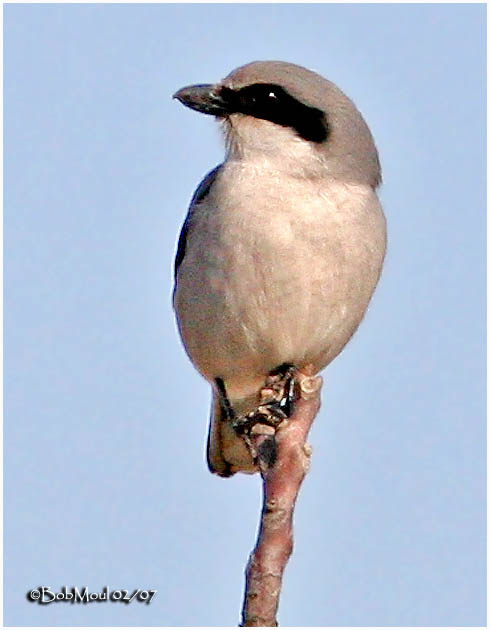
VOICE: SOUNDS BY XENO-CANTO
Loggerhead Shrike utters a rasping, buzzy “jehrr” or “zzchrr” repeated. Song is a medley of low warblers and harsh, squeaky notes. During courtship period, both male and female give a range of noises, unmusical series of notes. Call is a series of harsh “shack-shack”.
HABITAT:
Loggerhead Shrike lives in open and semi-open country with scattered trees and bushes. It is present in desert shrublands, in juniper or pinyon-juniper woodlands, and often around the boundaries of ranches and towns.
RANGE:
Loggerhead Shrike lives in many parts of Central Canada, border of Canada states and in the Greater Midwest of the United States. During spring and summer migrations, it may be seen in California, southern Mexico and Florida.
It winters from southern Oregon and Kansas, Tennessee and Virginia, and southwards, to southern Mexico.
Northern populations are migratory.
BEHAVIOUR:
Loggerhead Shrike preys on large insects and small vertebrates. Shrike has strong, hooked bill, but lacks talons and has weak feet. It can kill and tear prey apart with the bill, but it can’t kill, carry and hold prey from its feet.
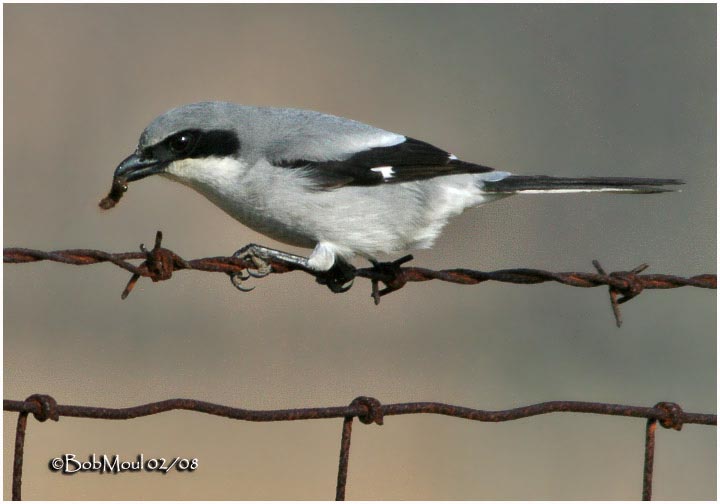
Loggerhead Shrike kills small rodents and small birds by biting them at the back of the head or on the neck, in order to sever the spinal cord of its prey with its strong notch, or “tooth” near the bill tip. Sometimes, several bits are required to kill a prey. It may also beat larger preys against the ground or tree trunk.
Because its weak feet, Loggerhead Shrike has difficulty to hold prey firmly with its feet. So, it uses an alternative method, to immobilize the carcass, by impaling it on thorns or barbed wire, or broken pointed twigs, or also by wedging the prey into a crotch in a tree or a bush.
Loggerhead Shrike doesn’t eat its prey the day of the kill, but it may return within one or two days to eat it, or it may never do so.
This fact was interpreted as constituting food storage, but generally, the meat left impaled is mainly the least digestible parts of the preys.
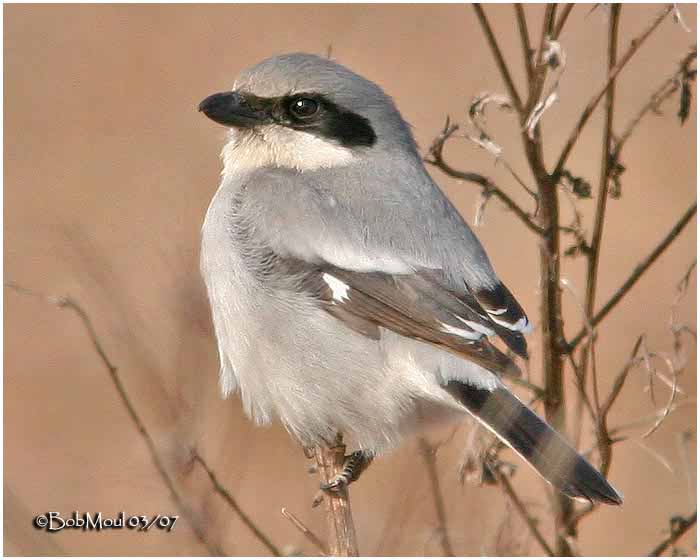
Loggerhead Shrike uses perch from which it launches its attack when prey is detected. We can observe two kinds of “still-hunting”, active and passive (Alden Miller). Shrike employs active hunting in the early morning and early evening hours, using hunting perches at about 6 feet from the ground, from which it watches over the adjacent area. It also may hunt on the ground, hoping around in low shrubs, searching for food. This is the active hunting.
Passive hunting takes place during the day, after first preys have quenched the bird’s hunger. Now, it can be more selective. Bird perches on the top of a tree or on telephone wires, in order to scan the ground to a distance of 150 feet of the perch. If no prey is captured during about 10 to 30 minutes, the Shrike moves on to another perch.
Loggerhead Shrike is not gregarious. Each bird establishes feeding territory at the end of the breeding season or after migration. These territories are defended by advertising calls, by perching on high perches. When another shrike enters territory boundaries, the resident utters series of sharp “bzeek” repeated, and if the intruder insists, they fight.
Territory includes good cover, high observation poles, roosting site, and on breeding territory, the nest-site.
During breeding season, the behaviour is based around hunting. Shrike needs to hunt for hunger, for young and to attract female for procreation. That is the dominant factor in its life.
During spring, male often kills prey, in order to display its power. This behaviour attracts a female seeking a dominant male, able to feed a family.
FLIGHT:
Loggerhead Shrike performs a rapid flight with quick wing strokes. It also flies with fluttering wings, and then a glide, displaying the broad white wing bars.
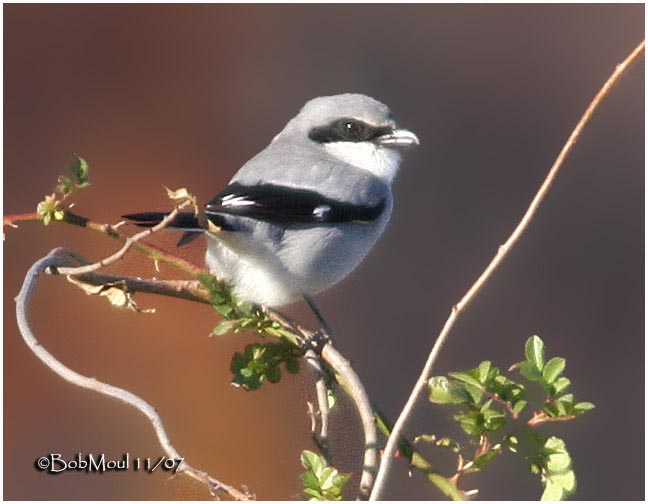
REPRODUCTION:
Loggerhead Shrike is a solitary nester. They are mainly monogamous, but females may mate with another male after the first brood has left the nest, and raise a second brood with other male.
Male and female share the nest selection, and both gather nest materials. Female usually builds the cup-shaped nest, a well-made structure, weaving dead plant materials. Nest is made of thick twigs woven together, and lined with fibres and padded with feathers, hair or cotton. Nest may protect against sun, rain and storms. It is situated in dense cover, at about 1 to 2,5 metres above the ground, but it may be placed higher. Female needs 6 to 11 days to build it.
Female lays 5 to 7 greyish buff eggs spotted with dark. Incubation starts when last eggs are almost laid. Female incubates and she is fed by the male. Incubation lasts about 16 to 17 days.
Altricial chicks hatch naked and blind. Both parents keep them warm and fed. Adults may bring food at nest every 4 or 5 minutes. Within 15 days, chicks of about 3,2 grams at hatching weigh now about 47 grams, as adults.
Young leave the nest at about 17 to 20 days after hatching. They remain into nearby branches and return to the nest to be brooded at night by their mother. They are fed by both parents for 2 to 3 weeks after left the nest, and they learn to hunt and become independent.
By early September, family group breaks up, and birds begin their migration to winter areas.
This species produces two broods per year, occasionally three in southern parts of the range.
DIET :
Loggerhead Shrike feeds mainly on insects (grasshoppers and beetles) during breeding season. They prey on both vertebrates and invertebrates. They feed on mice, small amphibians and small birds.
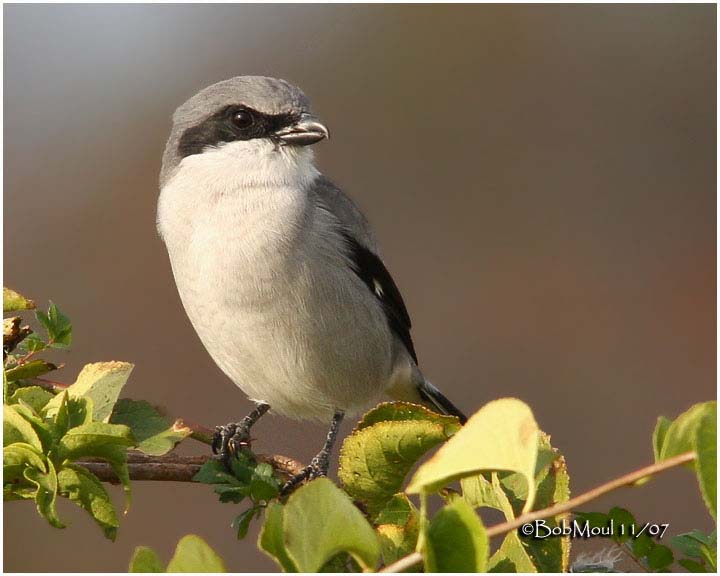
PROTECTION / THREATS / STATUS :
Loggerhead Shrike is very useful, consuming large numbers of pests of agricultural crops. Throughout North America, Loggerhead is in decline. The two Canadian subspecies, Eastern Loggerhead Shrike and Prairie Loggerhead Shrike are endangered. The most endangered subspecies of the Loggerhead Shrike is the one found on San Clemente Island, California (it is very distinctive, being smaller than the others, and much darker).
Shrikes have several predators such as Magpies, Crows, snakes, cats and weasels. But habitat loss plays a very important role in these declines.
Their last remaining habitats are often along roadsides, where birds frequently are victims of collisions. Pesticides contamination may also be a factor.
Fr: Pie grièche migratrice
All : Louisianawürger
Esp : Alcaudón Testarudo
Ital : Averla americana
Nd : Amerikaanse Klapekster
Russe : Американский сорокопут
Sd : Amerikansk törnskata
Photographs by Bob Moul
His website :
Nature Photography
Text by Nicole Bouglouan
Sources :
HANDBOOK OF THE BIRDS OF THE WORLD Vol 13 by Josep del Hoyo-Andrew Elliot-Jordi Sargatal - Lynx Edicions – ISBN: 9788496553453
FIELD GUIDE TO THE BIRDS OF NORTH AMERICA - National Geographic Society - ISBN: 0792274512
BIRDS OF THE GREAT BASIN – by Fred A. Ryser - Univ of Nevada Pr -ISBN: 0874170796
All About Birds (Cornell Lab of Ornithology)
What Bird-The ultimate Bird Guide (Mitchell Waite)
Bird Web (Seattle Audubon Society)